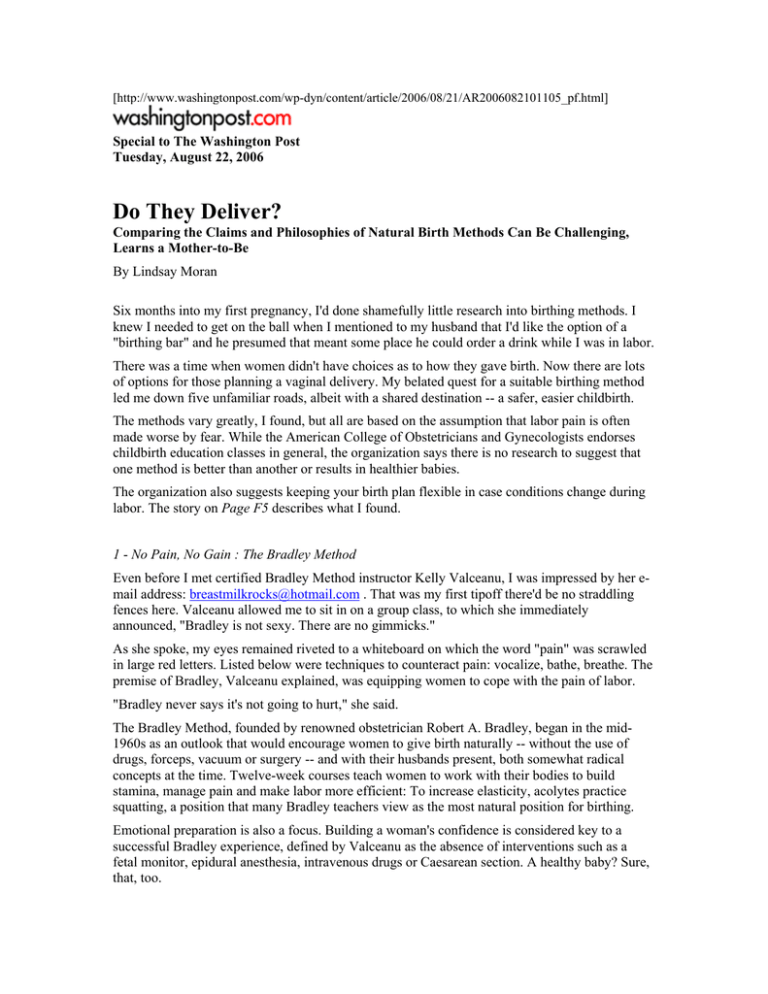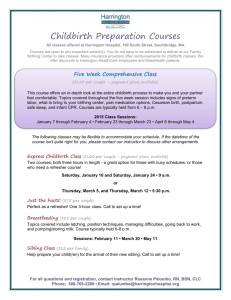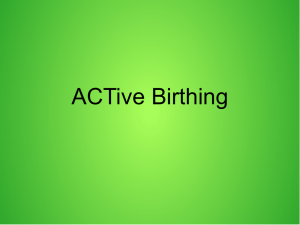Do They Deliver?
advertisement

[http://www.washingtonpost.com/wp-dyn/content/article/2006/08/21/AR2006082101105_pf.html] Special to The Washington Post Tuesday, August 22, 2006 Do They Deliver? Comparing the Claims and Philosophies of Natural Birth Methods Can Be Challenging, Learns a Mother-to-Be By Lindsay Moran Six months into my first pregnancy, I'd done shamefully little research into birthing methods. I knew I needed to get on the ball when I mentioned to my husband that I'd like the option of a "birthing bar" and he presumed that meant some place he could order a drink while I was in labor. There was a time when women didn't have choices as to how they gave birth. Now there are lots of options for those planning a vaginal delivery. My belated quest for a suitable birthing method led me down five unfamiliar roads, albeit with a shared destination -- a safer, easier childbirth. The methods vary greatly, I found, but all are based on the assumption that labor pain is often made worse by fear. While the American College of Obstetricians and Gynecologists endorses childbirth education classes in general, the organization says there is no research to suggest that one method is better than another or results in healthier babies. The organization also suggests keeping your birth plan flexible in case conditions change during labor. The story on Page F5 describes what I found. 1 - No Pain, No Gain : The Bradley Method Even before I met certified Bradley Method instructor Kelly Valceanu, I was impressed by her email address: breastmilkrocks@hotmail.com . That was my first tipoff there'd be no straddling fences here. Valceanu allowed me to sit in on a group class, to which she immediately announced, "Bradley is not sexy. There are no gimmicks." As she spoke, my eyes remained riveted to a whiteboard on which the word "pain" was scrawled in large red letters. Listed below were techniques to counteract pain: vocalize, bathe, breathe. The premise of Bradley, Valceanu explained, was equipping women to cope with the pain of labor. "Bradley never says it's not going to hurt," she said. The Bradley Method, founded by renowned obstetrician Robert A. Bradley, began in the mid1960s as an outlook that would encourage women to give birth naturally -- without the use of drugs, forceps, vacuum or surgery -- and with their husbands present, both somewhat radical concepts at the time. Twelve-week courses teach women to work with their bodies to build stamina, manage pain and make labor more efficient: To increase elasticity, acolytes practice squatting, a position that many Bradley teachers view as the most natural position for birthing. Emotional preparation is also a focus. Building a woman's confidence is considered key to a successful Bradley experience, defined by Valceanu as the absence of interventions such as a fetal monitor, epidural anesthesia, intravenous drugs or Caesarean section. A healthy baby? Sure, that, too. Valceanu said her classes tend to attract Type A personalities drawn to a method that requires organization and control. When she added, "There's at least one attorney in every class," one woman's hand shot up, proving Valceanu's point. By the end of the class, I wasn't sure that Bradley was for me, but I saw its merit -- a tough-love philosophy of childbirth, with an emphasis on nutrition, exercise and -- above all -- being prepared to cope with pain. 2 - Melodrama: The Alexander Technique I sat on a chair in the middle of Lynn Brice Rosen's District studio, making myself aware, as per her instruction, of the way the chair supported my buttocks, which in turn supported my ribs, which then supported my head. The Alexander Technique, of which Rosen is a practitioner, originated in the 1800s as a way for actors, singers and musicians to perform to their fullest potential. By promoting a greater awareness of how posture can affect every bodily function, including voice, the technique claims to alleviate pain caused by poor comportment and bad habits, such as slouching or bending over to lift. Adherents learn "to alter everyday gestures, and thus achieve greater freedom of movement, better balance and coordination," Rosen explained. She says the method also facilitates an easier birth process. After the chair exercise, Rosen instructed me to get on the floor and perform a number of what she called "polar bear rolls." I tucked my legs, wrapped my arms around my chest, and rolled from side to side on my back. Although I had no idea how this would help during childbirth, it felt good to roll around on the carpeted floor. Rosen sent me a book whose photographs of an enormously pregnant but somehow poised woman straddling an oversized rubber ball inspired me to invest in one such prop myself. Months later, the birthing ball would remain an unused obstacle in the delivery room. Now, my 16month-old son enjoys playing with it. 3 - Mind Over Matter: HypnoBirthing When HypnoBirthing instructor Laura Marks told us to picture "a warm kitchen with happy memories," all I could visualize was the house in which I grew up; in my mental image, I sat on the floor crying while my parents fought about what kind of linoleum to put down. How such thoughts would ease me through labor eluded me. HypnoBirthing is a natural childbirth method that emphasizes what its practitioners call "the FearTension-Pain syndrome." Learn to control the first response, the idea goes, and you can minimize the last. The key to breaking the cycle, according to HypnoBirthers? Self-hypnosis. Twelve hours of classes with a certified instructor, in conjunction with home self-hypnosis exercises, teach women techniques that, according to devotees, eliminate the fears prompted by the pain of labor. Studies out of Harvard and elsewhere have suggested that self-hypnosis may alleviate pain and stress. Marks described HypnoBirthing as a philosophy that "relies on the physical, mental and spiritual preparation of both the expectant mother and her partner." During the class I attended, Marks also introduced us to the language of HypnoBirthing, which covers nearly every aspect of labor. A contraction is a wave, or a surge of power. A coach is a companion. A baby is not delivered; he or she is birthed. Water does not break; rather, membranes are released. And, most important, pain is not really pain, but merely pressure . The mind-over-matter approach is similar to that used by athletes who suffer injuries in the middle of an important game or competition. Given my lack of stoicism on the playing field along with my seeming inability to mentally transport myself, I decided that HypnoBirthing was unlikely to work for me. That said, in following months I encountered several women who swore by it. 4 - The "Natural" Route: Lamaze For many people, childbirth classes are virtually synonymous with Lamaze, a technique that gained wide popularity in the 1960s. Controlled breathing, meant to help women concentrate during labor and distract them from their pain, is the Lamaze method's presumed trademark. But according to certified Lamaze instructor Sarah Sragg, Lamaze puts greater emphasis on activity -- such as walking and changing position during childbirth. Lamaze also incorporates massage, hydrotherapy and the use of heat and cold to relieve painful contractions -- and seeks to equip husbands or partners with an array of methods to make them feel (and be) useful during the birth process. Procrastinator that I am, I didn't get around to sampling Lamaze until I was pregnant with my second child. Pity, as I felt at once comforted by Sragg's approach when I met her in her Silver Spring home, where she sometimes conducts private lessons. "We encourage natural childbirth without any medical interventions," Sragg said. "But we also cover how to combine Lamaze techniques with an epidural, if needed." According to Sragg, Lamaze has evolved over time in response to societal and environmental changes. Like both Valceanu and Marks, Sragg is a doula, a professional labor assistant, trained in offering emotional support and expertise before, during and after birth. Many women, she says, want both classes and a doula, and she typically assists in three labors per month. "Ten years ago, that wasn't so popular," she said. "Now women are permitted to have several of what we call 'support people' in the delivery room." Another reason Lamaze appealed to me was its sheer convenience. While most birthing classes require a longer commitment, Lamaze classes can be taught as a two-day "intensive" version and a one-day "express" course for couples who lack the time for a weekly class or the foresight to sign up far in advance. As I faced my second labor with a demanding toddler at home, if some kind of drive-thru birthing method were available, I'd probably have opted for that. 5 - Eleventh-Hour Parents: Hospital Classes A mere two weeks before I gave birth the first time, I found myself in a classroom with several other visibly uncomfortable pregnant women and their partners, all of whom had settled on the instruction provided by Sibley Hospital. (No, you don't have to wait until the last minute; you can sign up for hospital classes any time during pregnancy.) My husband and I signed up for three classes: baby care, breast-feeding and labor and delivery. In the breast-feeding class, I realized neither of us possessed the maturity to have a child; we both giggled over a slide featuring an engorged breast. During baby care class, we heard rapid-fire instruction on how to tend to a newly circumcised penis. Later, I looked back upon what I hoped would be extensive notes, and was chagrined to discover only two words: petroleum jelly. During labor and delivery class, the instructor mentioned that women might get "crabby and irrational during the active phase of labor," and one husband shouted out, "My wife's been in labor for the past two years then." On the tour of the maternity ward, another husband asked if the delivery room TVs got ESPN. To me, the primary comfort of the hospital-provided classes was finding myself among likeminded parents. Maybe a few of the husbands were a bit boorish, but at least there was no one who appeared any less clueless or nervous than we were. · Lindsay Moran is a Washington area freelance writer. Comments: health@washpost.com. © 2006 The Washington Post Company



